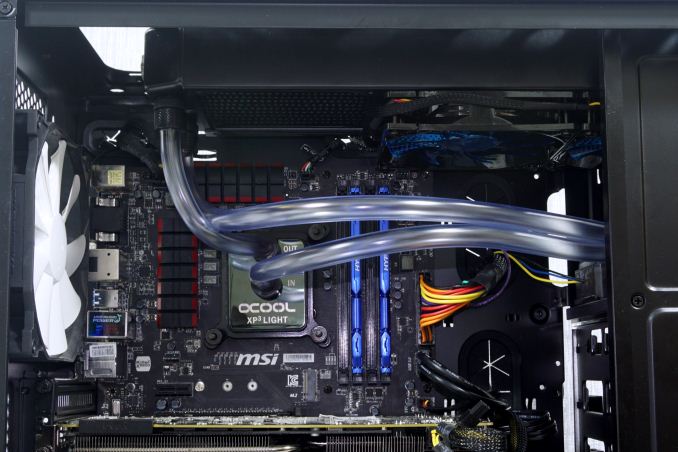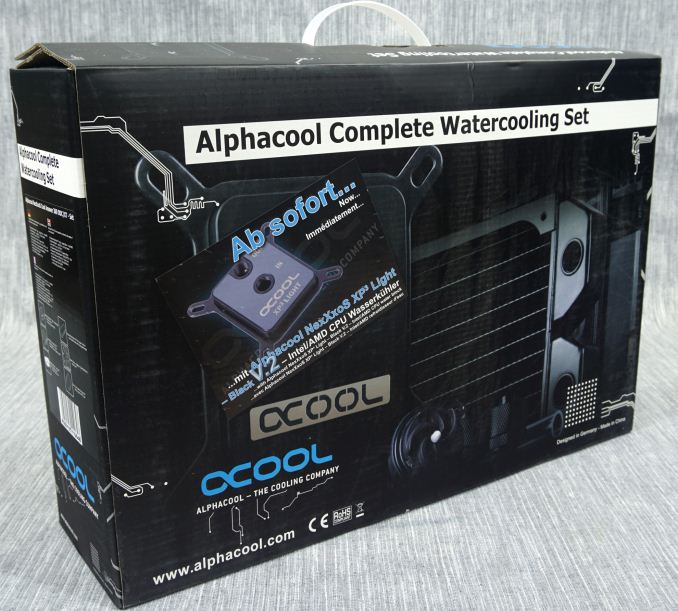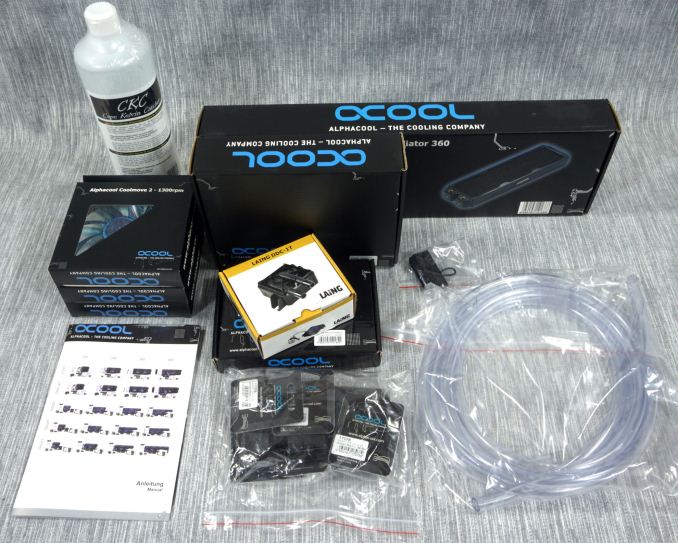The Alphacool NexXxoS Cool Answer 360 DDC/XT Liquid Cooling Kit Review
by E. Fylladitakis on October 24, 2016 9:30 AM EST
Not so long ago, PC liquid cooling was considered to be an extreme approach, one performed by hardcore enthusiasts and overclockers alone. There were no commercial products available and every individual system was designed by the user. Radiators were modified heater cores extracted from cars, CPU blocks were rare and occasionally machined at local workshops using a copper block and a mill, while high-performance tubing came from shops with medical supplies.
As demand grew, aided by the ever-increasing noise of small CPU heatsinks, companies specializing in these "open loop" liquid cooling solutions began turning up -- a little too fast perhaps, as tens of companies were founded within a few months' time and very few of them actually survived for more than a couple of years. Enthusiasts could then buy specialized liquid cooling equipment and even whole kits from just one seller and only had to assemble the setup into their system. That of course is no simple process for an amateur and a nightmare for a system builder, who had to find ways to ship systems pre-filled with coolant or assume that the user has the skills required to fill & maintain such a system. The payoff in terms of cooling was often immense, but the potential market remained limited to advanced users only.
Liquid coolers finally achieved adoption with the wider enthusiast use base at the start of this decade, when the likes of Asetek and CoolIT Systems came up with an inexpensive closed loop solutions, a design was just as simple to install as a common air cooler and required virtually no maintenance at all. However, as convenient as these all-in-one (AIO) solutions may be, hardcore enthusiasts find them lacking and inflexible. Some of the compact AIO designs can hardly compete against air-based solutions in terms of performance. A few companies began making their systems expandable, but the main parts of the system still cannot be upgraded. As such, AIO coolers rarely are acceptable solutions for the most hardcore of enthusiasts and overclockers, who need the best performance and still prefer designing and building their own liquid cooling systems.
Alphacool is a German designer and manufacturer of liquid cooling systems for PCs who has also diversified into producing liquid cooling systems for industrial and medical applications. They are one of the oldest companies in the field and, even though we did have a review of their recent Eisbaer AIO solutions, their specialization lies with the design, manufacturing and supply of high performance liquid cooling parts for advanced PCs.
Except from individual parts, Alphacool also supplies their products as complete pre-tested kits. It is one of these kits that we will be reviewing today, the NexXxoS Cool Answer 360 DDC/XT. The kit includes:
- 1x Alphacool NexXxoS XP3 Light Cooling Block
- 1x Alphacool Repack 5,25 Bay Reservoir
- 1x Laing 12V DDC-1T Pump
- 1x Alphacool NexXxoS XT45 Full Copper Radiator
- 3 meters AlphaTube tubing HF 13/10 (3/8“ID) - clear
- 6x Alphacool HF 13/10 Compression Fittings G1/4
- 3x 120 mm Alphacool Coolmove Fans
- 1x Alphacool CKC Cape Kelvin Catcher Liquid 1000ml
- 1x ATX-bridging plug (24 Pin) - black
Packaging & Bundle
Alphacool supplies the NexXxoS Cool Answer 360 DDC/XT kit in a large, very sturdy cardboard box. The artwork is simple, based on pictures of the included parts and basic information about the kit.
Every included part is packed in its own cardboard box, meaning that the exterior box only provides shipping convenience and protection. The packaging of the individual parts, with the exception of the liquid pump, bears the Alphacool company logo. The clear PVC tubing does not have its own packaging, though that would be redundant as it is nearly impossible to damage such an item during transport. Alphacool also supplies a thorough manual.












40 Comments
View All Comments
BrokenCrayons - Tuesday, October 25, 2016 - link
Thats sort of the point I'm getting at here. CPU performance has become a lot less relevant in recent years. Sandy Bridge's realease is a pretty good place to draw a line in the sand about when that sort of thing happened. I'd say perhaps a little earlier than that, but the target of acceptable CPU performace is still moving along slowly, but hardly keeping up with the release of new generations these days which in turn devalues the meaningfulness of overclocking and therefore the usefulness of creative cooling methods.GPUs are another story, of course. Higher screen resolutions and maybe VR depending on whether or not it survives the coming couple of years will continue to drive GPU demand and maybe make it worth the effort to do something unusual with a video card to wring a little more out of it.
Batmeat - Monday, October 24, 2016 - link
This setup would be easy to cut the noise by simply swapping out the fans, changing the mounting location of your pump and resevoir, and finally adding some dynamat around the pump and mount site.Dynamat was used back in the day by car stereo enthusiasts to deaden vibration from the subs in your vehicle. I would imagine something better is available today as I haven't messed around with the stuff for nearly 20 years.
JoeyJoJo123 - Monday, October 24, 2016 - link
If we're talking sound isolation material, then thick Rock Wools (used as in-wall insulation or as wood-framed panels in hi-fi home theatre rooms) and Sorbothane (used to acoustically/vibrationally isolate two objects, through a sorbothane gasket, feet, pads, etc)Neither material is particularly ideal to place inside a computer case.
The most sure-fire method to totally remove the noise from a PC is to literally move into another room. You can connect the peripherals such as mouse, keyboard, monitors through extended cables running through the wall into the adjacent room's closet, for example.
Arbie - Monday, October 24, 2016 - link
I stopped even thinking about water cooling when the CPU ability trajectory crossed my needs line. In fact I no longer consider overclocking. A good Intel CPU now, stock, is almost *twice* as powerful as my high-wattage OC'd beast from 8 years ago. Even that rig rarely struggles now, and when there is a slowdown it is almost always due to the GPU or the disk I/O.If I were building now I might OC by a few percent, and upgrade a bit from the stock air cooler, but that's it.
Speaking generally here, to the average enthusiast. Put your money in the GPU, the disk I/O, and lots of RAM. Pushing your CPU will bring no perceptible gains for the expense, increased heat, and reliability concerns. In particular, forget about water cooling.
JoeyJoJo123 - Monday, October 24, 2016 - link
It really depends on the application you're running. Generally, the CPU isn't taxed much, and you're right about that.But in other cases, the CPU is taxed _a_lot_ and having a fat overclock can make a large difference. For example, right now I'm planning a dedicated streaming PC, complete with 3 general purpose capture cards (HDMI/Analog video per card). OBS can use Intel QuickSync, etc, but the entire point of having a dedicated streaming PC is to have a high quality streaming experience that offloads extra video capture work to a different PC. The best video quality comes from utilizing x264 to single-pass encode incoming raw video, and of course, this is software encoding so it's taxing on the CPU.
http://www.anandtech.com/bench/CPU/53
I can't honestly explain the outlier of the 6700 being significantly faster than a higher clocked 6700K, but ultimately that x264 single pass performance relies mostly in having high IPC first, and lots of cores second, which is why 3.5GHz 28 thread monsters sit lower on the list as compared to a 4.7GHz 8 thread 4790k.
Right now, I'd say the best possible dedicated streaming PC would have a highly overclocked (~4.8GHz) 6700k, which would likely allow the user to set up slower presets for a potentially higher quality stream, given a fixed bitrate upload speed (as in Twitch), etc.
So yeah, in some cases a fat overclock does help. It really comes down to whether the task is CPU/GPU/Storage starved. (Amdahl's law, etc.)
bearxor - Tuesday, October 25, 2016 - link
One thing I'd like to see mentioned in the review for a kit like this that I didn't see here (did I miss it?) is expandability. Can I add a vga cooler in the line and the pump/fans/radiator can handle it? Can I add two cards?qasdfdsaq - Wednesday, October 26, 2016 - link
Yes, and yes. That's basically the point of an open-loop system to begin with.(Incidentally I have the same kit and I bought it primarily to cool my ridiculous heating plant of a GPU)
bearxor - Saturday, October 29, 2016 - link
I'm not saying you couldn't do this, because obviously you can, but what's the impact to the coooing performance if you put a 150-200W GPU part in the line here.Since this is the first cooling loop review they've done in forever they're hopefully looking for feedback on what they'd like to see in future reviews and that's what I'd like to see.
Someone looking at a kit like this would obviously, IMO, be looking at it as a starter kit to expand upon in the future. A review should address what impact that expansion could have on the cooling performance of this kit.
microsofthelpnumber - Wednesday, October 26, 2016 - link
Microsoft Help Number UKMicrosoft is a brand name for many computing services. No matter what problem you are facing with which Microsoft product. Our team has expertise on every problem of Microsoft. To seek help call on@0800-098-8371.For More Details Please Click Here:-
http://microsofthelpnumber.co.uk/
Mariam24 - Wednesday, October 26, 2016 - link
Are you single tonight? A lot of beautiful girls waiting for you to https://goo.gl/PSgNLj